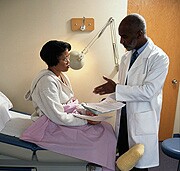
FRIDAY, April 9 (HealthDay News) — Once-a-year screening for chlamydia isn’t likely to protect women from developing pelvic inflammatory disease, researchers say.
A new study has found that most cases of pelvic inflammatory disease occur in women who didn’t have chlamydia infection when they were screened, which suggests they may have become infected later.
Chlamydia is the most common sexually transmitted infection in Europe and the United States. An estimated 3 million new infections are diagnosed annually, and because there are often no symptoms, many cases remain undiagnosed, according to background information provided in a news release about the study. Undiagnosed chlamydia infection may lead to pelvic inflammatory disease.
The study included 2,529 sexually active females, aged 16 to 27, who completed questionnaires and provided vaginal swabs to check for chlamydia. Some of the swabs (1,254) were tested immediately while others (1,265) were tested after a year.
Chlamydia was found in 68 (5.4 percent) of the women who were screened at the start of the study and in 75 (5.9 percent) of those screened a year later. During the study period, pelvic inflammatory disease developed in 15 (1.3 percent) of the women who were screened immediately and in 23 (1.9 percent) of those who were screened after one year.
The majority of cases of pelvic inflammatory disease (79 percent) were among women who tested negative for chlamydia at their initial screening, the study authors found. This suggests that, among high-risk people, frequent testing for chlamydia may be more effective at preventing pelvic inflammatory disease than annual screening, said Dr. Pippa Oakeshott, of the University of London, and colleagues.
Public campaigns should emphasize the need for screening whenever a woman has a new sexual partner, the study authors recommended in the report published online April 9 in BMJ.
“It is disappointing but not surprising that this study could not provide a clear answer as to whether screening is effective in reducing the incidence of pelvic inflammatory disease,” Jessica Sheringham, of University College London, wrote in an editorial accompanying the study.
More information
The U.S. National Women’s Health Information Center has more about pelvic inflammatory disease.

